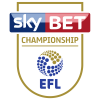Your Team's Top 10 Prospects
- Thread starter Sticktape
- Start date
You are using an out of date browser. It may not display this or other websites correctly.
You should upgrade or use an alternative browser.
You should upgrade or use an alternative browser.
- Status
- Not open for further replies.
newfy
Registered User
- Jul 28, 2010
- 14,771
- 8,327
Getting 4 regular NHLers out of your prospect pool would be a huge success, statistically speaking. Criticising the model on those grounds suggests an unrealistic understanding of how many drafted prospects turn into NHL players.
It absolutely would not be a huge success in Detroits situation. Not even counting the high picks like Edvinsson, Raymond and Seider, guys like Veleno, Berggren, some of their dmen etc etc and you only get 4 players out of those? That would be horrible. Given what theyve done in pro leagues, its hard to imagine Seider, Edvinsson and RAymond all alone not making the NHL, even if they arent studs. Add in their other 50 prospects (exaggeration) from the last 3 drafts and it would be a massive failure
Does it though?
It would surely be interesting to try and create a team that's drafted solely based on such models.
Dmitri Klopov over Drew Doughty?
Axel Holmström over Dylan Larkin?
Cody Corbett over Hampus Lindholm?
Ryan Pilon over Thomas Chabot?
David Kvasnicka over Cale Makar?
Ryan Siedem over Moritz Seider?
Extreme examples but it's not hard to find.
My impression is that when those models are correct, they're correct by a little bit (like ranking someone drafted in the 2nd/3rd as a 1st round caliber talent). But when they're wrong, they're extremely wrong.
Picking anecdotes doesn't say much. I could easily pick many examples the other way.
Claude Giroux > James Sheppard.
Nylander/Ehlers/Pastrnak > Virtanen/Fleury
Brayden Point > Connor Bleakley
Alex Debrincat > Riley Tufte
Nick Suzuki > Michael Rasmussen
Mat Barzal > Zach Senyshyn
Kyle Connor > Jakub Zboril
Sebastian Aho > Mitchell Stephens
Connor Garland > Devante Stephens
You would need to look at backward casts of many drafts to make a determination. And though most NHLe models are primarily points-based, they do adjust for age and size (as Top Down Hockey's model does). The point isn't that they're the end-all of drafting. It's that if a team can't consistently out-perform a model based on limited information, that's a pretty pathetic indication of the club's scouting.
IIRC, Canucks Army created a "model" that literally just drafted the highest scoring draft eligible CHL player. They excluded all other leagues from being selected to the model's team, including European leagues and USHL/college. They looked at like 15 drafts and the model still rated in the middle of the pack in terms of selecting regular NHLers.
Draftman
Registered User
This was hard because Dobson, Wahlstrom, and Sorokin have all graduated IMO. Leaving the team with many B level prospects. Feel free to completely disagree with the following list:

1. Samuel Bolduc (D)
2. Robin Salo (D)
3. Bode Wilde (D)
4. Kieffer Bellows (F)
5. Aatu Räty (F)
6. William Dufour (F)
7. Simon Holmström (F)
8. Alexander Ljungkrantz (F)
9. Alex Jefferies (F)
10. Ruslan Iskhakov (F)
11. Otto Koivula (F)
12. Collin Adams (F)
1. Samuel Bolduc (D)
2. Robin Salo (D)
3. Bode Wilde (D)
4. Kieffer Bellows (F)
5. Aatu Räty (F)
6. William Dufour (F)
7. Simon Holmström (F)
8. Alexander Ljungkrantz (F)
9. Alex Jefferies (F)
10. Ruslan Iskhakov (F)
11. Otto Koivula (F)
12. Collin Adams (F)
HABS
1. Cole Caufield
2. Kaiden Guhle
3. Logan Mailloux
4. Luke Tuch
5. Jan Mysak
6. Jordan Harris
7. Mattias Norlinder
8. Jesse Ylonen
9. Riley Kidney
10a. Jayden Struble
10b. Sean Farrell
Mysak a bit high; Tuch too.
My list would be the following
1. Caufield
2. Guhle
3. Harris
4. Mailloux
5. Norlinder
6. Ylonen
7. Struble
8. Primeau
9. Mysak
10. Tuch
Pavels Dog
Registered User
Well your examples basically prove my point, that the model's "successes" are minor (such as having Suzuki above Rasmussen when they were both rated as top 6 of that draft), while it's errors can be insane, i.e. giving Cale Makar close to a 4th round ranking.Picking anecdotes doesn't say much. I could easily pick many examples the other way.
Claude Giroux > James Sheppard.
Nylander/Ehlers/Pastrnak > Virtanen/Fleury
Brayden Point > Connor Bleakley
Alex Debrincat > Riley Tufte
Nick Suzuki > Michael Rasmussen
Mat Barzal > Zach Senyshyn
Kyle Connor > Jakub Zboril
Sebastian Aho > Mitchell Stephens
Connor Garland > Devante Stephens
You would need to look at backward casts of many drafts to make a determination. And though most NHLe models are primarily points-based, they do adjust for age and size (as Top Down Hockey's model does). The point isn't that they're the end-all of drafting. It's that if a team can't consistently out-perform a model based on limited information, that's a pretty pathetic indication of the club's scouting.
IIRC, Canucks Army created a "model" that literally just drafted the highest scoring draft eligible CHL player. They excluded all other leagues from being selected to the model's team, including European leagues and USHL/college. They looked at like 15 drafts and the model still rated in the middle of the pack in terms of selecting regular NHLers.
If a calculator gave you good answers 50% of the time, but 50% of the time calculated 1+1 to be 17, that would be known as a broken calculator.
It's also telling that you use mainly forwards for your examples; my original argument being that this type of model serves no purpose when ranking d-men. On the forward side there's more of a case to be made that it's not useless. I'm guessing the Canucks Army example ended up with a team of some decent forwards but zero d-men?
majormajor
Registered User
- Jun 23, 2018
- 24,682
- 29,387
Well your examples basically prove my point, that the model's "successes" are minor (such as having Suzuki above Rasmussen when they were both rated as top 6 of that draft), while it's errors can be insane, i.e. giving Cale Makar close to a 4th round ranking.
If a calculator gave you good answers 50% of the time, but 50% of the time calculated 1+1 to be 17, that would be known as a broken calculator.
It's also telling that you use mainly forwards for your examples; my original argument being that this type of model serves no purpose when ranking d-men. On the forward side there's more of a case to be made that it's not useless. I'm guessing the Canucks Army example ended up with a team of some decent forwards but zero d-men?
I don't have time to check it myself, but when they say they ran it in previous years to check the accuracy, it should be assumed they were looking at overall results and not just pairwise hits or misses. Not having Cale Makar isn't just a miss on one player, it's a miss on a ton of value, and I would guess that's already factored in.
Fantomas
Registered User
- Aug 7, 2012
- 13,304
- 6,638
Mysak a bit high; Tuch too.
My list would be the following
1. Caufield
2. Guhle
3. Harris
4. Mailloux
5. Norlinder
6. Ylonen
7. Struble
8. Primeau
9. Mysak
10. Tuch
Farrell's going to surprise a lot of people.
Fantomas
Registered User
- Aug 7, 2012
- 13,304
- 6,638
Does it though?
It would surely be interesting to try and create a team that's drafted solely based on such models.
Dmitri Klopov over Drew Doughty?
Axel Holmström over Dylan Larkin?
Cody Corbett over Hampus Lindholm?
Ryan Pilon over Thomas Chabot?
David Kvasnicka over Cale Makar?
Ryan Siedem over Moritz Seider?
Extreme examples but it's not hard to find.
My impression is that when those models are correct, they're correct by a little bit (like ranking someone drafted in the 2nd/3rd as a 1st round caliber talent). But when they're wrong, they're extremely wrong.
You're assuming that people who use such models are imbeciles (or that they can't differentiate between a defenseman and a forward). They don't have to be.
You can use a PNHLe model and still have common sense to know that Drew Doughty is better than Dmitri Klopov (besides people who use PNHLe always state the caveat that it doesn't work as well for Euro leagues).
Although I'm not an advanced stats nut, I think there should be a conversation about this. NHL teams are very bad at drafting. This is known.
Fantomas
Registered User
- Aug 7, 2012
- 13,304
- 6,638
Melvin on the Canucks board created his "potato" drafting model based solely on points/NHLe. It drafts better than quite a few NHL teams.
On this topic, may I please have a link to this thread?
David Bruce Banner
Nude Cabdriver Ban
On this topic, may I please have a link to this thread?
I think this is what the poster was talking about...
The Data-Based Drafting Thread (what players would a Potato pick?)
Or this...
Assessing NHL Drafting Ability
Maybe @Melvin will appear to speak on the topic as he is the Potato Progammer.
- Sep 27, 2017
- 5,387
- 2,729
Kings:
With Bjornfot, Anderson, Vilardi graduating, I'd say
Quinton Byfield
Brandt Clarke
Alex Turcotte
Arthur Kaliyev
Brock Faber
Sammy Fagemo
Tyler Madden
Francesco Pinelli
Helge Grans
Akil Thomas
HM
Rasmus Kupari, Jordan Spence, Kim Nousiainen, and like 30 more 'B' prospects and i'm sure someone i'm forgetting haha
Not a fan of Grans.
But, and I mean this with respect...**** You guys. It's a haul.
Sensinitis
Registered User
- Aug 5, 2012
- 15,934
- 5,526
Stützle, Norris, Batherson, Brannstrom graduating changes this list a lot from last year :

1. Sanderson
2. Pinto
3. Greig
4. Formenton
5. Gustavsson
6. Boucher
7. JBD
8. Sokolov
9. L. Brown (needs to get healthy and head out of ass)
10. Kleven
HM : Merilainen/Sogaard

1. Sanderson
2. Pinto
3. Greig
4. Formenton
5. Gustavsson
6. Boucher
7. JBD
8. Sokolov
9. L. Brown (needs to get healthy and head out of ass)
10. Kleven
HM : Merilainen/Sogaard
AddyTheWrath
Registered User

1. Evan Bouchard
2. Dylan Holloway
3. Philip Broberg
4. Dmitri Samorukov
5. Ryan McLeod
6. Xavier Bourgault
7. Ilya Konovalov
8. Tyler Benson
9. Raphael Lavoie
10. William Lagesson
In my opinion, anyway.
johnnystormcgy
Registered User
- May 26, 2007
- 500
- 248
Sticking to players under 22 who haven't played in the NHL, since I consider 24-year-olds who haven't made the NHL yet to be depth players and not prospects, the Flames' prospect power ranking looks something like this:
1. Matthew Coronato
2. Connor Zary
---
3. Jakob Pelletier
4. Dustin Wolf (my favourite prospect personally, but goalies are voodoo and I'll wait to see how he transitions to the AHL before I proclaim him our next saviour)
5. Jérémie Poirier
---
6. Ryan Francis
T-7. William Strömgren
T-7. Cole Jordan
9. I'm running out of plausible/non-embarrassing names here... let's say Emilio Pettersen
10. Yan Kuznetsov?
The top 5 is pretty clear to me and after that there's a whole lot of huh and maybe.
I agree with most of your list, would change it to this:
1. Matthew Coronato
2. Connor Zary
---
3. Jakob Pelletier
---
4. Dustin Wolf
---
5. Jérémie Poirier
6. Ryan Francis
7. Emil Heineman
8. William Strömgren
---
9. Johannes Kinnvall
10. Matthew Phillips
Kingfan1967
Registered User
- Oct 6, 2017
- 733
- 725
Not a fan of Grans.
But, and I mean this with respect...**** You guys. It's a haul.
Maybe a " haul " but the price for that haul was .... UGLY and it's still not a pretty picture yet ( maybe if the hockey gods smile on LA it will turn around as soon as this year ) .
Well your examples basically prove my point, that the model's "successes" are minor (such as having Suzuki above Rasmussen when they were both rated as top 6 of that draft), while it's errors can be insane, i.e. giving Cale Makar close to a 4th round ranking.
If a calculator gave you good answers 50% of the time, but 50% of the time calculated 1+1 to be 17, that would be known as a broken calculator.
It's also telling that you use mainly forwards for your examples; my original argument being that this type of model serves no purpose when ranking d-men. On the forward side there's more of a case to be made that it's not useless. I'm guessing the Canucks Army example ended up with a team of some decent forwards but zero d-men?
These are just names I pulled glancing at hockeyDB. I could find weirder comparisons if I wanted. But selecting a guy like Rasmussen vs. Suzuki is a massive miss. You've got, at best, a bottom-six player vs. a high-end piece. And further, the rest of the "misses" again are either replacement level players or not in the NHL. These are massive misses. You just choose to ignore that too. Pairwise comparisons are also a very poor way to evaluate draft success. You would need to evaluate multiple entire drafts, as I already said.
I mean, you're not proving anything either. You're citing one example (Makar) as the major reason the model is "broken". I mean yeah, I guess it's broken in the sense that it didn't value AJHL scoring because very few NHLers came through the AJHL.
Yes, most of the hits are going to be forwards. This is not a criticism I'm unaware of. The point is that a model that nearly exclusively selects forwards can still outperform actual NHL teams drafting. Again, this is much more of an indictment of actual scouting than the model. Your broken calculator analogy is really more applicable to NHL scouts picking guys like Connor Bleakley in the first round.
Pavels Dog
Registered User
No the peeve is the way this stuff is starting to get passed around as established science/fact, reaching people who don't understand how the models are built and what their flaws are, nor their track record.You're assuming that people who use such models are imbeciles (or that they can't differentiate between a defenseman and a forward). They don't have to be.
In my estimation, the people creating the models and visualisations are a bit overconfident in their work and seem to happily ignore sample size issues or the fact there are obvious flaws in the way the model rates d-men especially.
Things like this are very cool, but as expected it makes some really great forward selections (a theoretical draft year where you land Nylander, Pastrnak, Point and Arvidsson) and mostly fails to find any d-men (or goalies of course).I think this is what the poster was talking about...
The Data-Based Drafting Thread (what players would a Potato pick?)
I consider your examples mostly small victories for the model and they kind of get replaced by errors that are just as big if not bigger (in 2015 for example underrating Chabot, Werenski, vastly overrating Bracco).These are just names I pulled glancing at hockeyDB. I could find weirder comparisons if I wanted. But selecting a guy like Rasmussen vs. Suzuki is a massive miss. You've got, at best, a bottom-six player vs. a high-end piece. And further, the rest of the "misses" again are either replacement level players or not in the NHL. These are massive misses. You just choose to ignore that too. Pairwise comparisons are also a very poor way to evaluate draft success. You would need to evaluate multiple entire drafts, as I already said.
While drafting Suzuki ahead of Rasmussen would be the right move, there are far too many examples where the model rates players highly who go undrafted and don't even come close to sniffing NHL time.
Last edited:
newfy
Registered User
- Jul 28, 2010
- 14,771
- 8,327
These are just names I pulled glancing at hockeyDB. I could find weirder comparisons if I wanted. But selecting a guy like Rasmussen vs. Suzuki is a massive miss. You've got, at best, a bottom-six player vs. a high-end piece. And further, the rest of the "misses" again are either replacement level players or not in the NHL. These are massive misses. You just choose to ignore that too. Pairwise comparisons are also a very poor way to evaluate draft success. You would need to evaluate multiple entire drafts, as I already said.
Theyre 22, we'll see. But I wouldnt be using that as your example just yet. These guys are just getting started and it hardly proves your point. At best a bottom 6 player is bad analysis
David Bruce Banner
Nude Cabdriver Ban
The Potato Pick concept isn't trying to be the "best drafter"... it isn't even really trying at all, just selecting based solely upon weighted stats. The ideas was to see if, based upon a few basic criteria, it could do better than Benning (or Gillis). IIRC, the Potato's picks are around middle of the pack... some hits, some misses, but arguably better than a good chunk of NHL GM's and scouting staffs.
The Potato Pick concept isn't trying to be the "best drafter"... it isn't even really trying at all, just selecting based solely upon weighted stats. The ideas was to see if, based upon a few basic criteria, it could do better than Benning (or Gillis). IIRC, the Potato's picks are around middle of the pack... some hits, some misses, but arguably better than a good chunk of NHL GM's and scouting staffs.
Exactly. Everyone gets hung up on specific examples to try and "prove" that the model is wrong. That is not the point (and also a terrible way to analyze how effective the model is, but nevertheless).
The point is a very simplistic draft model, using extremely limited information, can outdraft quite a few NHL teams. This is much more of an indictment of NHL scouting staffs, who have millions of dollars of resources and staff at their disposal. Clearly, they're missing some things if you can get equal-ish performance from a literal spreadsheet.
No the peeve is the way this stuff is starting to get passed around as established science/fact, reaching people who don't understand how the models are built and what their flaws are, nor their track record.
In my estimation, the people creating the models and visualisations are a bit overconfident in their work and seem to happily ignore sample size issues or the fact there are obvious flaws in the way the model rates d-men especially.
Things like this are very cool, but as expected it makes some really great forward selections (a theoretical draft year where you land Nylander, Pastrnak, Point and Arvidsson) and mostly fails to find any d-men (or goalies of course).
I consider your examples mostly small victories for the model and they kind of get replaced by errors that are just as big if not bigger (in 2015 for example underrating Chabot, Werenski, vastly overrating Bracco).
While drafting Suzuki ahead of Rasmussen would be the right move, there are far too many examples where the model rates players highly who go undrafted and don't even come close to sniffing NHL time.
Hey, I understand that in terms of wanting to push their work, the owners may seem like they're saying this is the end-all be-all. From following many analytics guys closely, I can pretty confidently say this is not the case. And on the other side it should also be up to the people who are criticizing the models as "bad" to actually learn some more and come up with more coherent arguments other than "you rated this player low = model bad".
Again, picking specific player comparisons is absolutely not an efficient way to evaluate any model or club's draft selections. You would need to compare many years of drafts to all other clubs league-wide.
I don't understand why you're so hung up on drafting fewer defensemen. If any club walked out of the 2014 draft with Nylander, Pastrnak, Point, and Arvidsson (I also believe the Potato was high on Kase, who was also a good player before tough injuries), they would've had the greatest draft of all time. 3 bonafide star players and another 1st line player (at his peak). Who cares if they're not defensemen? You've drafted incredible players and if you need to balance your lineup, find a trade. This draft alone would've made "the Potato" one of the best-drafting teams of the 2010s.
Again, as I and @Regular David Bruce said before (which you don't seem to understand), the point of the models is not to create the end-all be-all of drafting (they're not even trying to do that). It's that using a very simplistic draft model, using extremely limited information, can outdraft quite a few NHL teams. This is much more of an indictment of NHL scouting staffs, who have millions of dollars of resources and staff at their disposal. Clearly, they're missing some things if you can get equal-ish performance from a literal spreadsheet.
AKA Chief
Registered User
- Sep 29, 2017
- 256
- 191
1. Vitali Kravtsov
2. Nils Lundkvist
3. Braden Schneider
4. Zac Jones
5. Brett Berard
6. Matthew Robertson
7. Morgan Barron
8. Lauri Pajuniemi
9. Tarmo Reunanen
10. Brennan Othmann
No biggie but I think Jones should be 3. I think he showed immense promise in his cameo at the end of last season.
- Apr 2, 2008
- 25,823
- 13,514
Sens list with my expectations as far as what the players realistically project as.
1. Jake Sanderson - #1 defenseman
2. Shane Pinto - 2nd line center
3. Erik Brannstrom - 2nd pairing D
4. Egor Sokolov - 2nd line RW
5. Jacob Bernard Docker - 2nd pairing D
6. Tyler Boucher - 3rd line RW
7. Ridly Greig - 3rd line C/LW
8. Alex Formenton - 3rd line LW
9. Tyler Kleven - 3rd pairing D
10. Logan Brown - 2nd line center (but high bust potential)
1. Jake Sanderson - #1 defenseman
2. Shane Pinto - 2nd line center
3. Erik Brannstrom - 2nd pairing D
4. Egor Sokolov - 2nd line RW
5. Jacob Bernard Docker - 2nd pairing D
6. Tyler Boucher - 3rd line RW
7. Ridly Greig - 3rd line C/LW
8. Alex Formenton - 3rd line LW
9. Tyler Kleven - 3rd pairing D
10. Logan Brown - 2nd line center (but high bust potential)
- Status
- Not open for further replies.
Ad
Upcoming events
-

-

-

-
 GAME 3 - Drummondville Voltigeurs @ Victoriaville Tigres - Drummondville Voltigeurs leads series 2-0Wagers: 1Staked: $35.00Event closes
GAME 3 - Drummondville Voltigeurs @ Victoriaville Tigres - Drummondville Voltigeurs leads series 2-0Wagers: 1Staked: $35.00Event closes- Updated:
-




